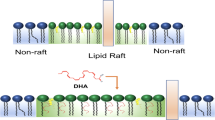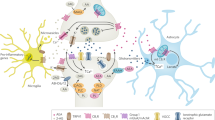Abstract
The corollaries of the obesity epidemic that plagues developed societies are malnutrition and resulting biochemical imbalances. Low levels of essential n-3 polyunsaturated fatty acids (n-3 PUFAs) have been linked to neuropsychiatric diseases, but the underlying synaptic alterations are mostly unknown. We found that lifelong n-3 PUFAs dietary insufficiency specifically ablates long-term synaptic depression mediated by endocannabinoids in the prelimbic prefrontal cortex and accumbens. In n-3–deficient mice, presynaptic cannabinoid CB1 receptors (CB1Rs) normally responding to endocannabinoids were uncoupled from their effector Gi/o proteins. Finally, the dietary-induced reduction of CB1R functions in mood-controlling structures was associated with impaired emotional behavior. These findings identify a plausible synaptic substrate for the behavioral alterations caused by the n-3 PUFAs deficiency that is often observed in western diets.
This is a preview of subscription content, access via your institution
Access options
Subscribe to this journal
Receive 12 print issues and online access
$209.00 per year
only $17.42 per issue
Buy this article
- Purchase on Springer Link
- Instant access to full article PDF
Prices may be subject to local taxes which are calculated during checkout





Similar content being viewed by others
References
Bourre, J.M. Dietary omega-3 Fatty acids and psychiatry: mood, behaviour, stress, depression, dementia and aging. J. Nutr. Health Aging 9, 31–38 (2005).
Rapoport, S.I., Rao, J.S. & Igarashi, M. Brain metabolism of nutritionally essential polyunsaturated fatty acids depends on both the diet and the liver. Prostaglandins Leukot. Essent. Fatty Acids 77, 251–261 (2007).
Lauritzen, L., Hansen, H.S., Jorgensen, M.H. & Michaelsen, K.F. The essentiality of long chain n-3 fatty acids in relation to development and function of the brain and retina. Prog. Lipid Res. 40, 1–94 (2001).
Simopoulos, A.P. Evolutionary aspects of the dietary omega-6:omega-3 fatty acid ratio: medical implications. World Rev. Nutr. Diet. 100, 1–21 (2009).
Parker, G. et al. Omega-3 fatty acids and mood disorders. Am. J. Psychiatry 163, 969–978 (2006).
Mingam, R. et al. Uncoupling of interleukin-6 from its signaling pathway by dietary n-3-polyunsaturated fatty acid deprivation alters sickness behaviour in mice. Eur. J. Neurosci. 28, 1877–1886 (2008).
Chalon, S. Omega-3 fatty acids and monoamine neurotransmission. Prostaglandins Leukot. Essent. Fatty Acids 75, 259–269 (2006).
Mackie, K. Signaling via CNS cannabinoid receptors. Mol. Cell. Endocrinol. 286, S60–S65 (2008).
Heifets, B.D. & Castillo, P.E. Endocannabinoid signaling and long-term synaptic plasticity. Annu. Rev. Physiol. 71, 283–306 (2009).
Leweke, F.M. & Koethe, D. Cannabis and psychiatric disorders: it is not only addiction. Addict. Biol. 13, 264–275 (2008).
Lutz, B. Endocannabinoid signals in the control of emotion. Curr. Opin. Pharmacol. 9, 46–52 (2009).
Hill, M.N. et al. The therapeutic potential of the endocannabinoid system for the development of a novel class of antidepressants. Trends Pharmacol. Sci. 30, 484–493 (2009).
Krishnan, V. & Nestler, E.J. The molecular neurobiology of depression. Nature 455, 894–902 (2008).
Nestler, E.J. & Carlezon, W.A. Jr. The mesolimbic dopamine reward circuit in depression. Biol. Psychiatry 59, 1151–1159 (2006).
Lafourcade, M. et al. Molecular components and functions of the endocannabinoid system in mouse prefrontal cortex. PLoS ONE 2, e709 (2007).
Robbe, D., Kopf, M., Remaury, A., Bockaert, J. & Manzoni, O.J. Endogenous cannabinoids mediate long-term synaptic depression in the nucleus accumbens. Proc. Natl. Acad. Sci. USA 99, 8384–8388 (2002).
Kauer, J.A. & Malenka, R.C. LTP: AMPA receptors trading places. Nat. Neurosci. 9, 593–594 (2006).
Hayton, S.J. Lovett-Barron, M., Dumont, E.C. & Olmstead, M.C. Target-specific encoding of response inhibition: increased contribution of AMPA to NMDA receptors at excitatory synapses in the prefrontal cortex. J. Neurosci. 30, 11493–11500 (2010).
Robbe, D., Alonso, G., Chaumont, S., Bockaert, J. & Manzoni, O.J. Role of p/q-Ca2+ channels in metabotropic glutamate receptor 2/3-dependent presynaptic long-term depression at nucleus accumbens synapses. J. Neurosci. 22, 4346–4356 (2002).
Mato, S., Lafourcade, M., Robbe, D., Bakiri, Y. & Manzoni, O.J. Role of the cyclic-AMP/PKA cascade and of P/Q-type Ca. channels in endocannabinoid-mediated long-term depression in the nucleus accumbens. Neuropharmacology 54, 87–94 (2008).
Mato, S. et al. A single in vivo exposure to delta 9THC blocks endocannabinoid-mediated synaptic plasticity. Nat. Neurosci. 7, 585–586 (2004).
Mikasova, L., Groc, L., Choquet, D. & Manzoni, O.J. Altered surface trafficking of presynaptic cannabinoid type 1 receptor in and out synaptic terminals parallels receptor desensitization. Proc. Natl. Acad. Sci. USA 105, 18596–18601 (2008).
Mato, S., Robbe, D., Puente, N., Grandes, P. & Manzoni, O.J. Presynaptic homeostatic plasticity rescues long-term depression after chronic Delta 9-tetrahydrocannabinol exposure. J. Neurosci. 25, 11619–11627 (2005).
Martin, B.R. Sim-Selley, L.J. & Selley, D.E. Signaling pathways involved in the development of cannabinoid tolerance. Trends Pharmacol. Sci. 25, 325–330 (2004).
Schlosburg, J.E., Sim-Selley, L.J., Liu, Q.S., Lichtman, A.H. & Cravatt, B.F. Chronic monoacylglycerol lipase blockade causes functional antagonism of the endocannabinoid system. Nat. Neurosci. 13, 1113–1119 (2010).
Berger, A. et al. Anandamide and diet: inclusion of dietary arachidonate and docosahexaenoate leads to increased brain levels of the corresponding N-acylethanolamines in piglets. Proc. Natl. Acad. Sci. USA 98, 6402–6406 (2001).
Matias, I. et al. Effect of polyunsaturated fatty acids on endocannabinoid and N-acyl-ethanolamine levels in mouse adipocytes. Biochim. Biophys. Acta 1781, 52–60 (2008).
Watanabe, S., Doshi, M. & Hamazaki, T. n-3 Polyunsaturated fatty acid (PUFA) deficiency elevates and n-3 PUFA enrichment reduces brain 2-arachidonoylglycerol level in mice. Prostaglandins Leukot. Essent. Fatty Acids 69, 51–59 (2003).
Vinod, K.Y. & Hungund, B.L. Role of the endocannabinoid system in depression and suicide. Trends Pharmacol. Sci. 27, 539–545 (2006).
DeMar, J.C. Jr. et al. One generation of n-3 polyunsaturated fatty acid deprivation increases depression and aggression test scores in rats. J. Lipid Res. 47, 172–180 (2006).
Porsolt, R.D., Brossard, G., Hautbois, C. & Roux, S. Rodent models of depression: forced swimming and tail suspension behavioral despair tests in rats and mice. Curr. Protoc. Neurosci. 14, 8.10A.1–8.10A.10 (2001).
Haller, J., Varga, B., Ledent, C., Barna, I. & Freund, T.F. Context-dependent effects of CB1 cannabinoid gene disruption on anxiety-like and social behaviour in mice. Eur. J. Neurosci. 19, 1906–1912 (2004).
Urigüen, L. Perez-Rial, S., Ledent, C., Palomo, T. & Manzanares, J. Impaired action of anxiolytic drugs in mice deficient in cannabinoid CB1 receptors. Neuropharmacology 46, 966–973 (2004).
Simon, P., Dupuis, R. & Costentin, J. Thigmotaxis as an index of anxiety in mice. Influence of dopaminergic transmissions. Behav. Brain Res. 61, 59–64 (1994).
Bambico, F.R., Katz, N., Debonnel, G. & Gobbi, G. Cannabinoids elicit antidepressant-like behavior and activate serotonergic neurons through the medial prefrontal cortex. J. Neurosci. 27, 11700–11711 (2007).
Evans, D.L. et al. Mood disorders in the medically ill: scientific review and recommendations. Biol. Psychiatry 58, 175–189 (2005).
Samat, A., Tomlinson, B., Taheri, S. & Thomas, G.N. Rimonabant for the treatment of obesity. Recent Patents Cardiovasc. Drug Discov. 3, 187–193 (2008).
Jacob, W. et al. Endocannabinoids render exploratory behaviour largely independent of the test aversiveness: role of glutamatergic transmission. Genes Brain Behav. 8, 685–698 (2009).
Steiner, M.A. et al. Impaired cannabinoid receptor type 1 signaling interferes with stress-coping behavior in mice. Pharmacogenomics J. 8, 196–208 (2008).
Steiner, M.A., Marsicano, G., Wotjak, C.T. & Lutz, B. Conditional cannabinoid receptor type 1 mutants reveal neuron subpopulation-specific effects on behavioral and neuroendocrine stress responses. Psychoneuroendocrinology 33, 1165–1170 (2008).
Liperoti, R., Landi, F., Fusco, O., Bernabei, R. & Onder, G. Omega-3 polyunsaturated fatty acids and depression: a review of the evidence. Curr. Pharm. Des. 15, 4165–4172 (2009).
Folch, J., Lees, M. & Sloane Stanley, G.H. A simple method for the isolation and purification of total lipides from animal tissues. J. Biol. Chem. 226, 497–509 (1957).
Morrison, W.R. & Smith, L.M. Preparation of fatty acid methyl esters and dimethylacetals from lipids with boron fluoride-methanol. J. Lipid Res. 5, 600–608 (1964).
Kasanetz, F. & Manzoni, O.J. Maturation of excitatory synaptic transmission of the rat nucleus accumbens from juvenile to adult. J. Neurophysiol. 101, 2516–2527 (2009).
Di Marzo, V. et al. Leptin-regulated endocannabinoids are involved in maintaining food intake. Nature 410, 822–825 (2001).
De Marchi, N. et al. Endocannabinoid signalling in the blood of patients with schizophrenia. Lipids Health Dis. 2, 5 (2003).
Matias, I. et al. Regulation, function, and dysregulation of endocannabinoids in models of adipose and beta-pancreatic cells and in obesity and hyperglycemia. J. Clin. Endocrinol. Metab. 91, 3171–3180 (2006).
Richardson, D., Ortori, C.A., Chapman, V., Kendall, D.A. & Barrett, D.A. Quantitative profiling of endocannabinoids and related compounds in rat brain using liquid chromatography-tandem electrospray ionization mass spectrometry. Anal. Biochem. 360, 216–226 (2007).
Kingsley, P.J. & Marnett, L.J. LC-MS-MS analysis of neutral eicosanoids. Methods Enzymol. 433, 91–112 (2007).
Berton, O. et al. Essential role of BDNF in the mesolimbic dopamine pathway in social defeat stress. Science 311, 864–868 (2006).
Acknowledgements
The authors thank O. Lassalle for helping with illustrations, P. Chavis and M. Darnaudéry for helpful discussions, P. Birac and C. Tridon for taking care of the mice and S. Grégoire for technical help. This work was supported by INSERM (O.J.M.), Institut National de la Recherche Agronomique (S.L.), Région Aquitaine (O.J.M. and S.L.), Centro de Investigación Biomédica en Red en Enfermedades Neurodegenerativas (CIBERNED) and the Spanish Ministry of Health (FIS 070628, ISCIII, C.M.M., R.R.P. and S.M.).
Author information
Authors and Affiliations
Contributions
M.L. performed the electrophysiology experiments, conducted the data analyses and contributed to the design of the experiments. T.L and A.D. performed the behavioral experiments, conducted the data analyses and contributed to the design of the experiments. S.M. performed the cannabinoid biochemical experiments, conducted the data analyses and contributed to the design of the experiments. M.S. participated in the electrophysiology experiments. R.R.-P. and C.M. participated in the cannabinoid biochemical experiments. I.M. performed the endocannabinoid measurements and conducted the data analyses. V.D.S. performed the western blot experiments and conducted the data analyses. V.F.L. participated in the behavioral experiments. L.B. performed the lipid biochemistry experiments and conducted the data analyses. S.L. and O.J.M. equally supervised the project and wrote the manuscript.
Corresponding authors
Ethics declarations
Competing interests
The authors declare no competing financial interests.
Supplementary information
Supplementary Text and Figures
Supplementary Figures 1–3 (PDF 567 kb)
Rights and permissions
About this article
Cite this article
Lafourcade, M., Larrieu, T., Mato, S. et al. Nutritional omega-3 deficiency abolishes endocannabinoid-mediated neuronal functions. Nat Neurosci 14, 345–350 (2011). https://doi.org/10.1038/nn.2736
Received:
Accepted:
Published:
Issue Date:
DOI: https://doi.org/10.1038/nn.2736
This article is cited by
-
Cocaine-induced loss of LTD and social impairments are restored by fatty acid amide hydrolase inhibition
Scientific Reports (2023)
-
Cold stress combined with salt or abscisic acid supplementation enhances lipogenesis and carotenogenesis in Phaeodactylum tricornutum (Bacillariophyceae)
Bioprocess and Biosystems Engineering (2022)
-
Maternal n-3 Polyunsaturated Fatty Acid Enriched Diet Commands Fatty Acid Composition in Postnatal Brain and Protects from Neonatal Arterial Focal Stroke
Translational Stroke Research (2022)
-
Possible involvement of fatty acid binding proteins in psychiatric disorders
Anatomical Science International (2021)
-
Maternal dietary omega-3 deficiency worsens the deleterious effects of prenatal inflammation on the gut-brain axis in the offspring across lifetime
Neuropsychopharmacology (2021)



